
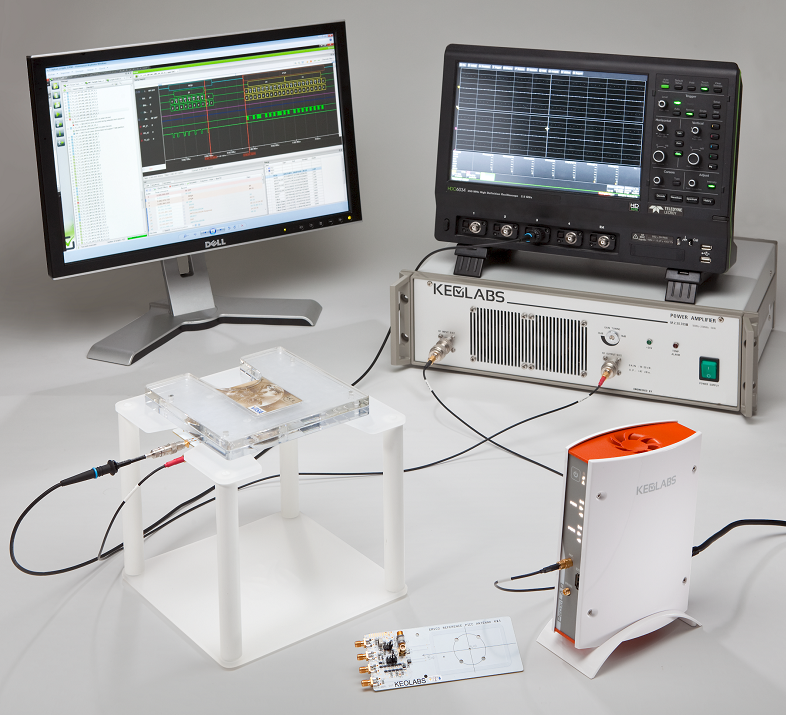


The Keolabs EMVCo L1 test solution supports RF and protocol layer testing for EMVCo L1 contactless cards and terminals, meets the new EMVCo specification requirements, and has been authorized by the EMVCo organization. It is the preferred EMVCo testing equipment in the industry.
EMVCo Level 1 PICC Analog test suite
EMVCo Level 1 PICC Digital test suite
EMVCo Level 1 Mobile Analog test suite
EMVCo Level 1 PCD Analog test suite
EMVCo Level 1 PCD Digital test suite
EMVCo Level 1 Reduced Range Terminal Analog test suite
At KEOLABS, all our platforms and solutions are EMVCo qualified.
EMV™ is the global standard for payment cards and readers based on contact and contactless smart card technologies. The EMV specifications encompass test procedures and compliance processes managed by EMVCo, an organisation jointly owned and operated by American Express, Discover, JCB, MasterCard, UnionPay and Visa.
KEOLABS provides complete testing solutions developed and qualified in accordance with EMVCo requirements.
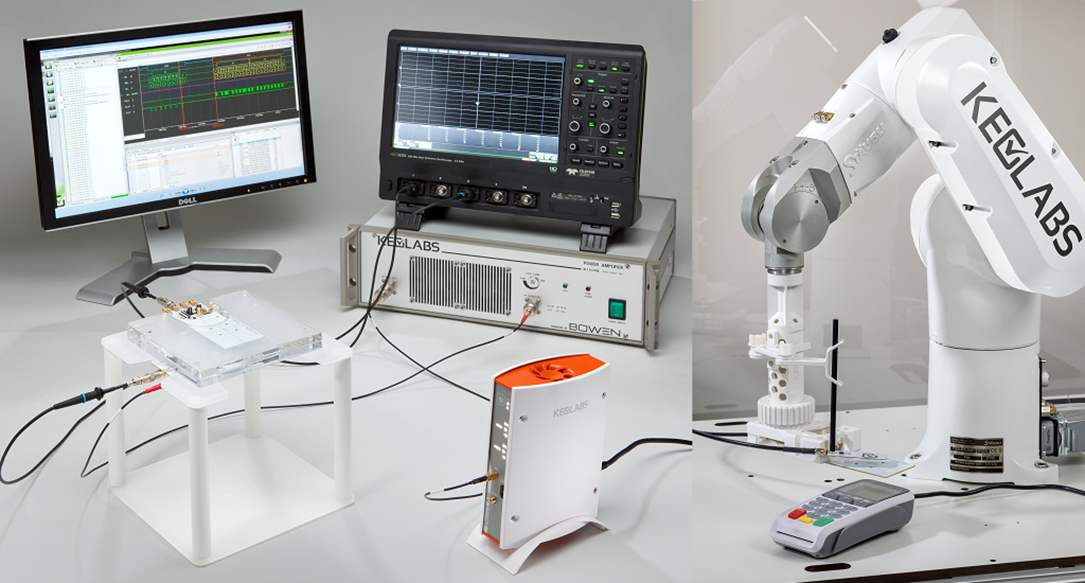
EMVCo Test suite for PICC Analog
• EMV Contactless Card Level 1 Type Approval – PICC Analogue Test Bench and Test Case Requirements, Version 3.2b, January 2025
EMVCo Test suite for PICC Digital
• EMV® Level 1 Specifications for Payment Systems - EMV® Contactless Interface Specification, Version 3.2 - July 2022
• EMV® Contactless Card Level 1 Type Approval - PICC Digital Test Cases, Version 3.2b - January 2025
• EMV® Mobile Product Level 1 Type Approval - Mobile L1 Test Guidelines, Version 3.2b - January 2025
EMVCo Test suite for Mobile Analog
• EMV Contactless Card Level 1 Type Approval – PICC Analogue Test Bench and Test Case Requirements, Version 3.2b, January 2025
• Mobile L1 Test Guidelines, Version 3.2b, January 2025
EMVCo Test suite for PCD Analog
• EMV® Level 1 Specifications for Payment Systems - EMV® Contactless Interface Specification, Version 3.2 - July 2022
• EMV® Contactless Terminal Level 1 Type Approval - PCD Analogue Test Bench and Test Case Requirements, Version 3.2a - January 2025
EMVCo Test suite for PCD Digital
• EMV® Level 1 Specifications for Payment Systems - EMV® Contactless Interface Specification - Version 3.2 - July 2022
• EMV® Contactless Terminal Level 1 Type Approval – PCD Digital Test Cases, Version 3.2a - January 2025
EMVCo Test suite for Reduced Range Terminal Analog
• EMVCo Contactless Terminal Level 1 Type Approval PCD Analogue Test Bench and Test Case Requirements, Version 3.1a, September 2021
• EMV RR L1 Test Guidelines, version 3.1a, September 2023
1 SCRIPTIS™ Test Environment
1 EMVCo L1 PCD Analog Test suite
1 EMVCo L1 PCD Digital Test suite
1 EMVCo L1 Mobile Analog Test suite
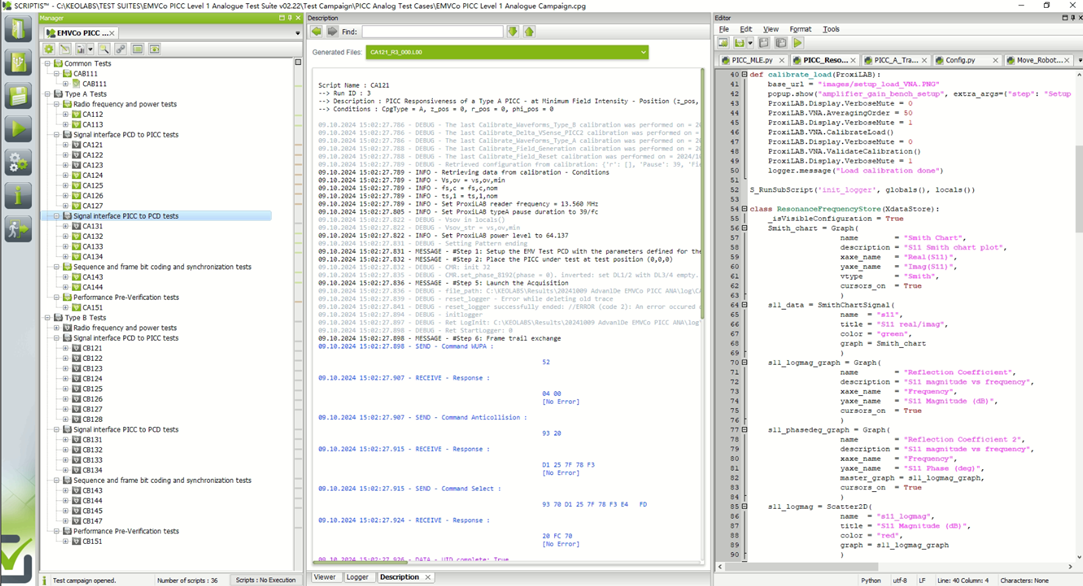
1 ProxiLAB QUEST tester with PCD Analog and Digital options
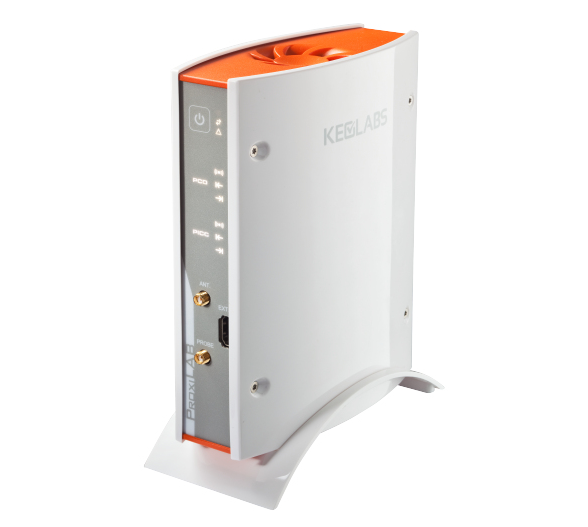
1 EMVCo Accessory set:
• SC-EMVCo Test PICC V3.0:Kit of 3 EMVCo PICC tuned at 3 frequencies (2 antennas class 1 tuned at 13.56 & 16.1MHz and 1 class 3 tuned at 13.56MHz.
• SC-EMVCo Test PCD V3.0:one EMVCo PCD antenna.
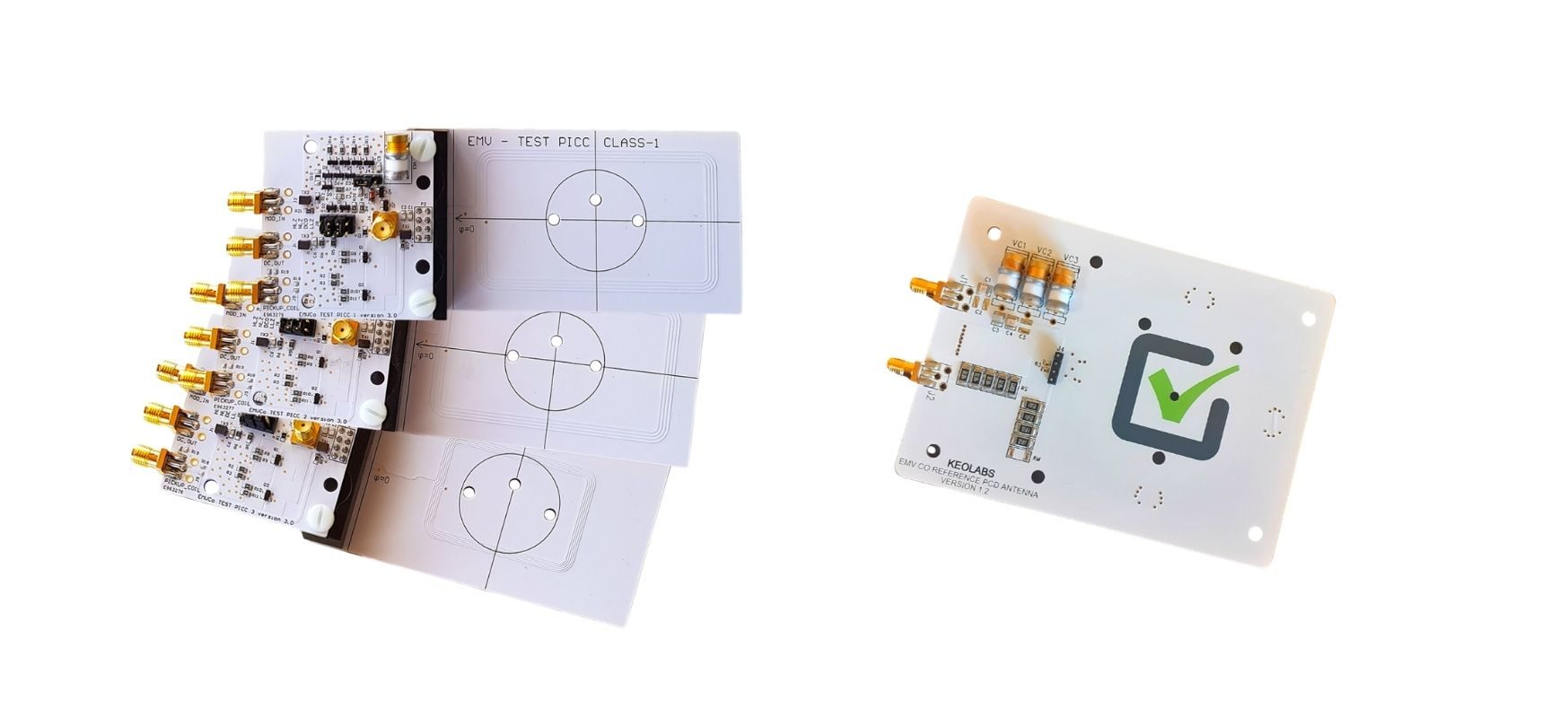
• SC-EMVCo KIT:In addition of the 3 EMVCo PICC references and the PCD antenna, 1 stand to mount the Test PCD with stackers and 1 CMR to condition the signals and switching them between its inputs and outputs for test bench set-ups are added.
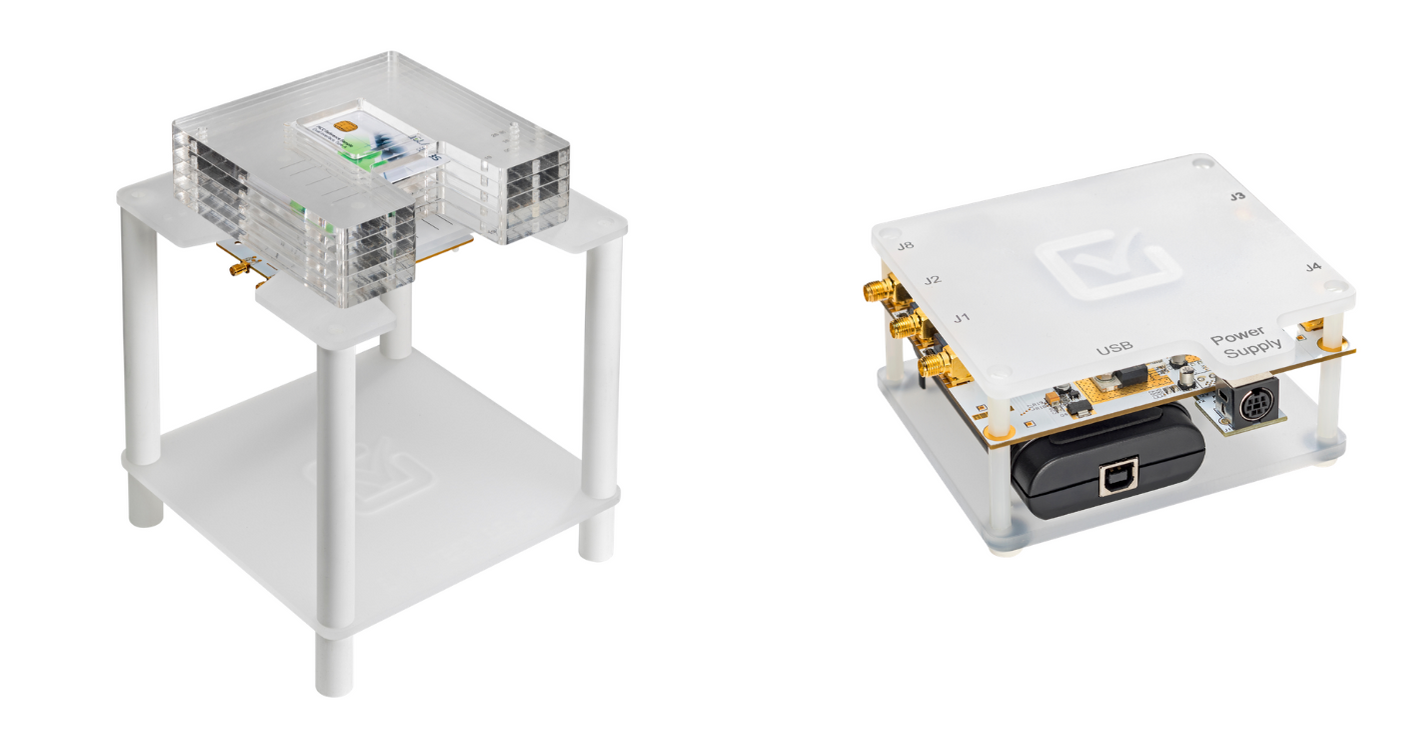
1 Robot 6 axis with dedicated accessories (optional)
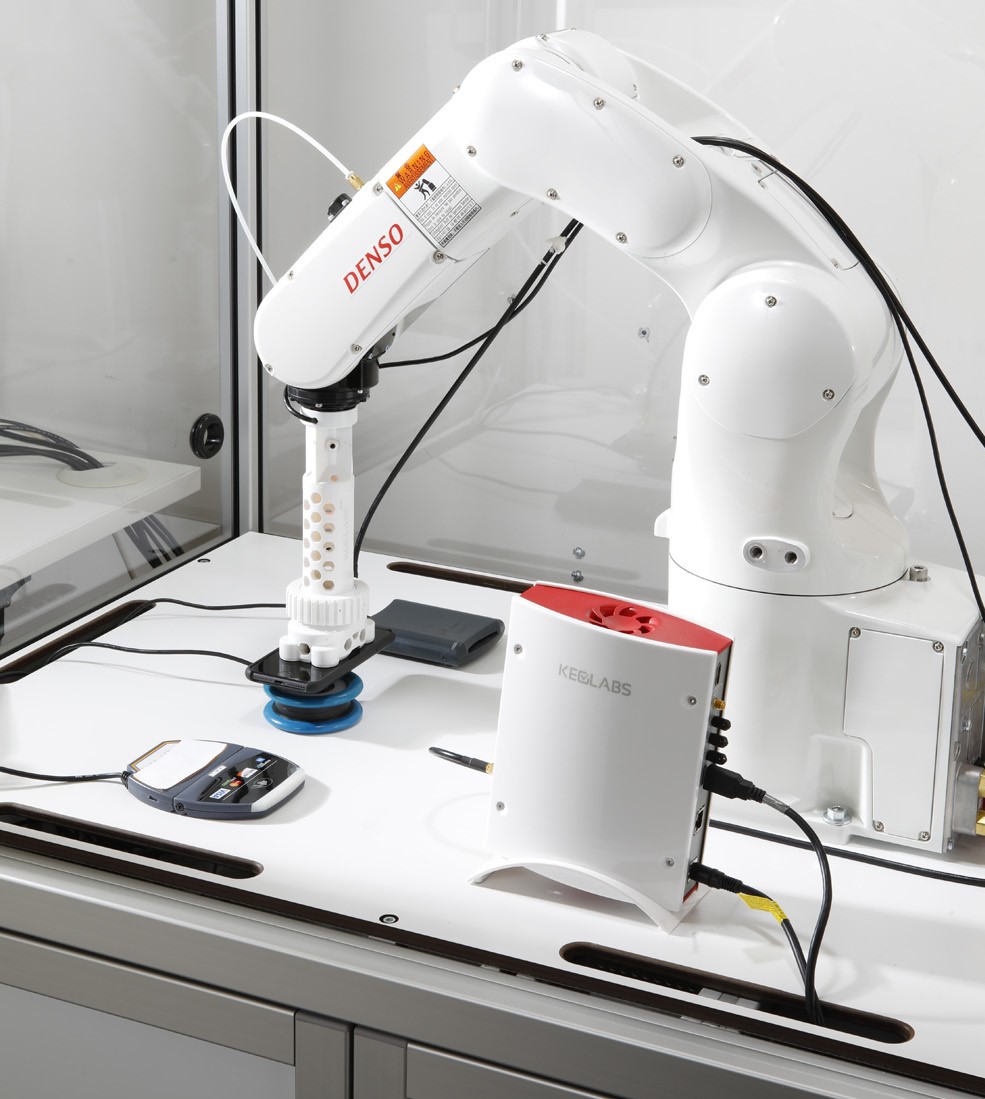
1 Lecroy HDO 6034-B Oscilloscope with Xdev option

1 Amplifier 50W, 10-250 MHz

This EMVCo PICC Analog test suite is compatible with the following standard:
EMV Contactless Card Level 1 Type Approval – PICC Analogue Test Bench and Test Case Requirements, Version 3.2b, January 2025
Our coverage of this test specification includes the following test cases (numbering according to the EMVCo version 3.2b):
PICC Power Off and Power On States Field
• §8.7.1.1. CA112.200 - PICC Power Off and Power On States Field - Power Off State for Type A
• §8.7.1.2. CA113.200 - PICC Power Off and Power On States Field - Power On State for Type A
• §8.7.1.3. CB112.200 - PICC Power Off and Power On States Field - Power Off State for Type B
• §8.7.1.4. CB113.200 - PICC Power Off and Power On States Field - Power On State for Type B
PICC Behavior with Respect to the Radio Frequency Field
• §8.7.2.1. CAB111.zrf - PICC behavior with respect to the RF Field - PICC Influence on the Field
PICC Responsiveness of a Type A PICC
• §8.7.3.1. CA121.zrf - PICC Responsiveness of a Type A PICC - at Minimum Field Intensity
• §8.7.3.2. CA122.zrf - PICC Responsiveness of a Type A PICC - at Maximum Field Intensity
• §8.7.3.3. CA123.zrf - PICC Responsiveness of a Type A PICC - at Nominal Field Intensity
• §8.7.3.4. CA124.200 - PICC Responsiveness of a Type A PICC - at Minimum Carrier Frequency
• §8.7.3.5. CA125.200 - PICC Responsiveness of a Type A PICC - at Maximum Carrier Frequency
• §8.7.3.6. CA126.z00 - PICC Responsiveness of a Type A PICC - at Minimum Timing t1
• §8.7.3.7. CA127.z00 - PICC Responsiveness of a Type A PICC - at Maximum Timing t1
Verifying the PICC Transmission for Type A
• §8.7.4.1. CA131.zrf - PICC Transmission for Type A - PICC load modulation
• §8.7.4.2. CA132.200 - PICC Transmission for Type A - PICC subcarrier frequency and bitrate at Nominal Frequency
• §8.7.4.3. CA133.200 - PICC Transmission for Type A - PICC subcarrier modulation
• §8.7.4.4. CA134.z00 - PICC Transmission for Type A - Verifying the Type A PICC Detectable Disturbances
Bit Level Coding for a Type A PICC
• §8.7.5.1. CA143.200 - Bit Level Coding for Type A - Bit Coding and De-synchronisation PICC to PCD
• §8.7.5.2. CA144.200 - Bit Level Coding for a Type A PICC - verifying Type A PICC Timings
Performance pre validation tests for a type A PICC
• §8.8.9.1 CA151.z00: Type A PICC Performance Pre-Verification - Verifying PICC transaction time, processing time & transmission tome
PICC Responsiveness of a Type B PICC
• §8.7.6.1. CB121.zrf - PICC Responsiveness of a Type B PICC - at Minimum Field Intensity
• §8.7.6.2. CB122.zrf - PICC Responsiveness of a Type B PICC - at Maximum Field Intensity
• §8.7.6.3. CB123.zrf - PICC Responsiveness of a Type B PICC - at Nominal Field Intensity
• §8.7.6.4. CB124.200 - PICC Responsiveness of a Type B PICC - at Minimum Carrier Frequency
• §8.7.6.5. CB125.200 - PICC Responsiveness of a Type B PICC - at Maximum Carrier Frequency
• §8.7.6.6. CB126.z00 - PICC Responsiveness of a Type B PICC - at Minimum PCD Modulation Index
• §8.7.6.7. CB127.z00 - PICC Responsiveness of a Type B PICC - at Maximum PCD Modulation Index
• §8.7.6.8. CB128.z00 - PICC Responsiveness of a Type B PICC - after a WUPA with t1 max and at Field Min
Verifying the PICC Transmission for Type B
• §8.7.7.1. CB131.zrf - PICC Transmission for Type B - PICC load modulation
• §8.7.7.2. CB132.200 - PICC Transmission for Type B - PICC subcarrier frequency and bitrate at Nominal-Minimum-Maximum Frequency
• §8.7.7.3. CB133.200 - PICC Transmission for Type B - PICC subcarrier modulation
• §8.7.7.4. CB134.z00 - PICC Transmission for Type B - Verifying the Type B PICC Detectable Disturbances
Bit level Coding for a Type B PICC
• §8.7.8.1. CB143.200 - Bit Level Coding for Type B - Bit Coding and De-synchronisation PICC to PCD
• §8.7.8.2. CB144.200 - Bit Level Coding for Type B - Bit Boundaries
• §8.7.8.3. CB145.200 - Bit Level Coding for a Type B PICC - verifying Type B PICC Timings
• §8.7.8.4. CB147.200 - Bit Level Coding for Type B - Verifying Maximum Bit Boundaries
Performance pre validation tests for a type B PICC
• §8.8.9.2 CB151.z00: Type B PICC Performance Pre-Verification - Verifying PICC transaction time, processing time & transmission tome
This EMVCo PICC Digital test suite is based on the standard:
EMV® Level 1 Specifications for Payment Systems - EMV® Contactless Interface Specification, Version 3.2 - July 2022
EMV® Contactless Card Level 1 Type Approval - PICC Digital Test Cases, Version 3.2b - January 2025
EMV® Mobile Product Level 1 Type Approval - Mobile L1 Test Guidelines, Version 3.2b - January 2025
Our coverage of this test specification includes the following test cases (numbering according to the EMVCo version 3.0b):
Type A Tests:
• §3.1. CA001, §3.2. CA002, §3.3. CA003, Basic Type A Exchange and Timings Measurement
• §3.4. CA010.XY, §3.5. CA011.XY, §3.6. CA012.XY, Basic Type A Exchange with the minimum and longer Frame Delay Times PCD to PICC
• §3.7. CA116, §3.8. CA117, §3.9. CA118, Type A Correct Installation with respect of the anticollision state machine
• §3.10. CA120.x, §3.11. CA121.x, §3.12. CA122.x, Type A Handling of RATS
• §3.13. CA126.x, §3.14. CA127.x, §3.15. CA128.x, Type A Consecutive Installations
• §3.16. CA130.x, §3.17. CA131.x, §3.18. CA132.x, Type A Handling of the REQA Command
• §3.19. CA204.x - Type A Installation with error in the IDLE state
• §3.20. CA206.xy, §3.21. CA207.xy, §3.22. CA208.xy, Type A Installation with error in the READY state
• §3.23. CA216.xy, §3.24. CA217.xy, §3.25. CA218.xy, Type A Installation with error in the ACTIVE state
• §3.26. CA226, §3.27. CA227, §3.28. CA228, Type A Installation with error in the HALT state following ACTIVE state
• §3.29. CA230, §3.30. CA231, §3.31. CA232, Type A Installation with error in the HALT state following PROTOCOL State
• §3.32. CA233.x - Type A Installation with polling and with PICC Reset
Type B Tests:
• §4.1. CB001 - Basic Type B Exchange and Timings Measurement
• §4.2. CB010.xy - Basic Type B Exchange with the minimum and longer Frame Delay Times PCD to PICC
• §4.3. CB015.xy - Basic Type B Exchange with the minimum supported SFGT PCD to PICC
• §4.4. CB021.x - Basic Type B Exchange with the minimum and the maximum values of EGT PCD
• §4.5. CB025.x - Basic Type B Exchange with minimum and maximum durations of (SoS) and (EoS)
• §4.6. CB116 - Type B Correct Installation with respect of the anticollision state machine
• §4.7. CB126.x - Type B Consecutive Installations (fixed PUPI, WUPB)
• §4.8. CB130.x - Type B Handling of the REQB Command (CUT in the READY State)
• §4.9. CB150 - Type B Correct Installation with C-APDU sent in the ATTRIB Command Higher Layer INF field
• §4.10. CB155.x - Type B Correct Installation with RFU values or values to be ignored
• §4.11. CB204.x - Type B Installation with error in the IDLE state
• §4.12. CB206.xy - Type B Installation with error in the READY state
• §4.13. CB226.x - Type B Installation with error in the HALT state following the READY state
• §4.14. CB227.x - Type B Installation with error in the HALT state following the ACTIVE State
• §4.15. CB228.x - Type B Installation with WUPA command in the HALT state
• §4.16. CB233.xy - Type B Installation with polling and with PICC Reset
Block Protocol Executable Tests:
• §5.1. CC001.x - Support of the EMV CL Polling
• §5.2. CC101.x - Reception of an empty I-Block or R(NAK) block
• §5.3. CC102 - Support of presence check procedure
• §5.4. CC110.x - Reception of chained I-Blocks from the PCD
• §5.5. CC120.x - Emission of APDUs with different FSDI values
• §5.6. CC203.x - Error notification on an I-Block not indicating chaining
• §5.7. CC206.xy - Error after reception of a non-chained I-Block
• §5.8. CC207 - Management of b2 in the PCB of S-Blocks
• §5.9. CC210.xy - Error notification and error after reception of a chained I-Block
• §5.10. CC233.xy - Block Protocol with PICC Reset
• §5.11. CC241.x - Installation commands during Block Protocol
• §5.12. CC245.x - Error at the beginning of the Block Protocol
This EMVCo Mobile Analogue test suite is compatible with the following standard:
EMV Contactless Card Level 1 Type Approval – PICC Analogue Test Bench and Test Case Requirements, Version 3.2b, January 2025
Mobile L1 Test Guidelines, Version 3.2b, January 2025
PICC Power Off and Power On States Field
• §8.7.1.1. CA112.200 - PICC Power Off and Power On States Field - Power Off State for Type A
• §8.7.1.2. CA113.200 - PICC Power Off and Power On States Field - Power On State for Type A
• §8.7.1.3. CB112.200 - PICC Power Off and Power On States Field - Power Off State for Type B
• §8.7.1.4. CB113.200 - PICC Power Off and Power On States Field - Power On State for Type B
PICC Behavior with Respect to the Radio Frequency Field
• §8.7.2.1. CAB111.zrf - PICC behavior with respect to the RF Field - PICC Influence on the Field
PICC Responsiveness of a Type A PICC
• §8.7.3.1. CA121.zrf - PICC Responsiveness of a Type A PICC - at Minimum Field Intensity
• §8.7.3.2. CA122.zrf - PICC Responsiveness of a Type A PICC - at Maximum Field Intensity
• §8.7.3.3. CA123.zrf - PICC Responsiveness of a Type A PICC - at Nominal Field Intensity
• §8.7.3.4. CA124.200 - PICC Responsiveness of a Type A PICC - at Minimum Carrier Frequency
• §8.7.3.5. CA125.200 - PICC Responsiveness of a Type A PICC - at Maximum Carrier Frequency
• §8.7.3.6. CA126.z00 - PICC Responsiveness of a Type A PICC - at Minimum Timing t1
• §8.7.3.7. CA127.z00 - PICC Responsiveness of a Type A PICC - at Maximum Timing t1
Verifying the PICC Transmission for Type A
• §8.7.4.1. CA131.zrf - PICC Transmission for Type A - PICC load modulation
• §8.7.4.2. CA132.200 - PICC Transmission for Type A - PICC subcarrier frequency and bitrate at Nominal Frequency
• §8.7.4.3. CA133.200 - PICC Transmission for Type A - PICC subcarrier modulation
• §8.7.4.4. CA134.z00 - PICC Transmission for Type A - Verifying the Type A PICC Detectable Disturbances
Bit Level Coding for a Type A PICC
• §8.7.5.1. CA143.200 - Bit Level Coding for Type A - Bit Coding and De-synchronisation PICC to PCD
• §8.7.5.2. CA144.200 - Bit Level Coding for a Type A PICC - verifying Type A PICC Timings
PICC Responsiveness of a Type B PICC
• §8.7.6.1. CB121.zrf - PICC Responsiveness of a Type B PICC - at Minimum Field Intensity
• §8.7.6.2. CB122.zrf - PICC Responsiveness of a Type B PICC - at Maximum Field Intensity
• §8.7.6.3. CB123.zrf - PICC Responsiveness of a Type B PICC - at Nominal Field Intensity
• §8.7.6.4. CB124.200 - PICC Responsiveness of a Type B PICC - at Minimum Carrier Frequency
• §8.7.6.5. CB125.200 - PICC Responsiveness of a Type B PICC - at Maximum Carrier Frequency
• §8.7.6.6. CB126.z00 - PICC Responsiveness of a Type B PICC - at Minimum PCD Modulation Index
• §8.7.6.7. CB127.z00 - PICC Responsiveness of a Type B PICC - at Maximum PCD Modulation Index
• §8.7.6.8. CB128.z00 - PICC Responsiveness of a Type B PICC - after a WUPA with t1 max and at Field Min
Verifying the PICC Transmission for Type B
• §8.7.7.1. CB131.zrf - PICC Transmission for Type B - PICC load modulation
• §8.7.7.2. CB132.200 - PICC Transmission for Type B - PICC subcarrier frequency and bitrate at Nominal-Minimum-Maximum Frequency
• §8.7.7.3. CB133.200 - PICC Transmission for Type B - PICC subcarrier modulation
• §8.7.7.4. CB134.z00 - PICC Transmission for Type B - Verifying the Type B PICC Detectable Disturbances
Bit level Coding for a Type B PICC
• §8.7.8.1. CB143.200 - Bit Level Coding for Type B - Bit Coding and De-synchronisation PICC to PCD
• §8.7.8.2. CB144.200 - Bit Level Coding for Type B - Bit Boundaries
• §8.7.8.3. CB145.200 - Bit Level Coding for a Type B PICC - verifying Type B PICC Timings
• §8.7.8.4. CB147.200 - Bit Level Coding for Type B - Verifying Maximum Bit Boundaries
Scriptis supports Python editing and modifying scripts:
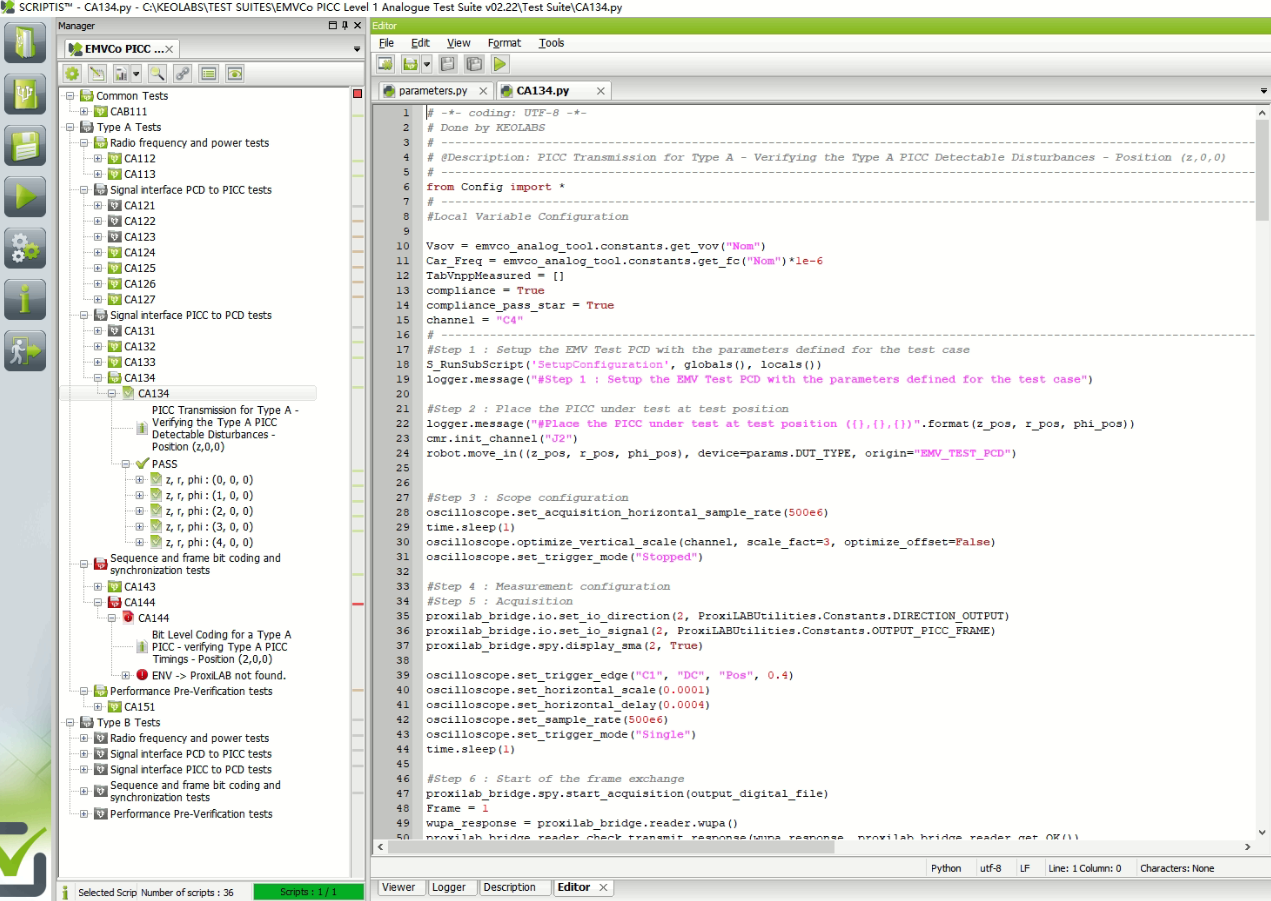
Scriptis saves test logs in TXT format:
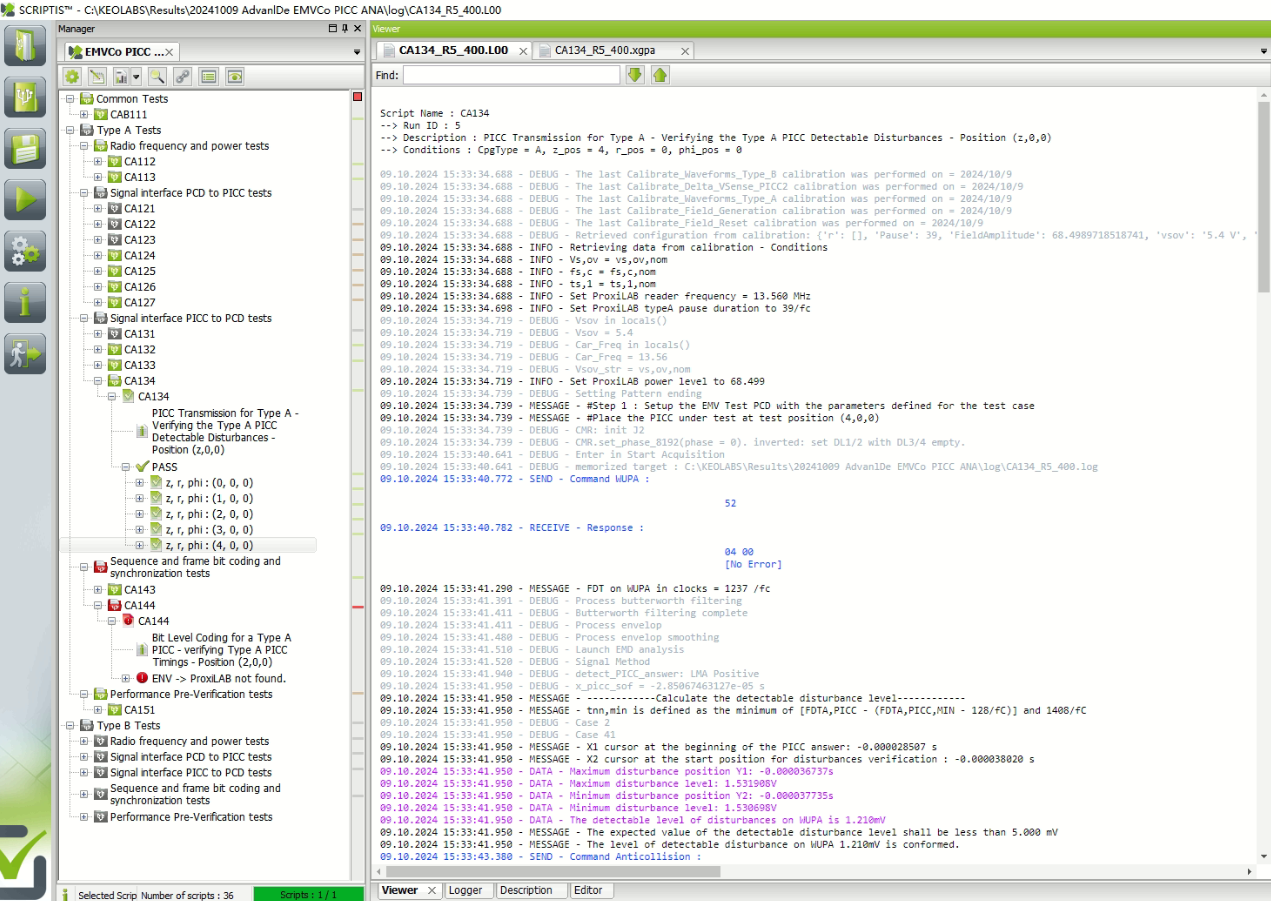
Scriptis saves test logs in xgpa format:
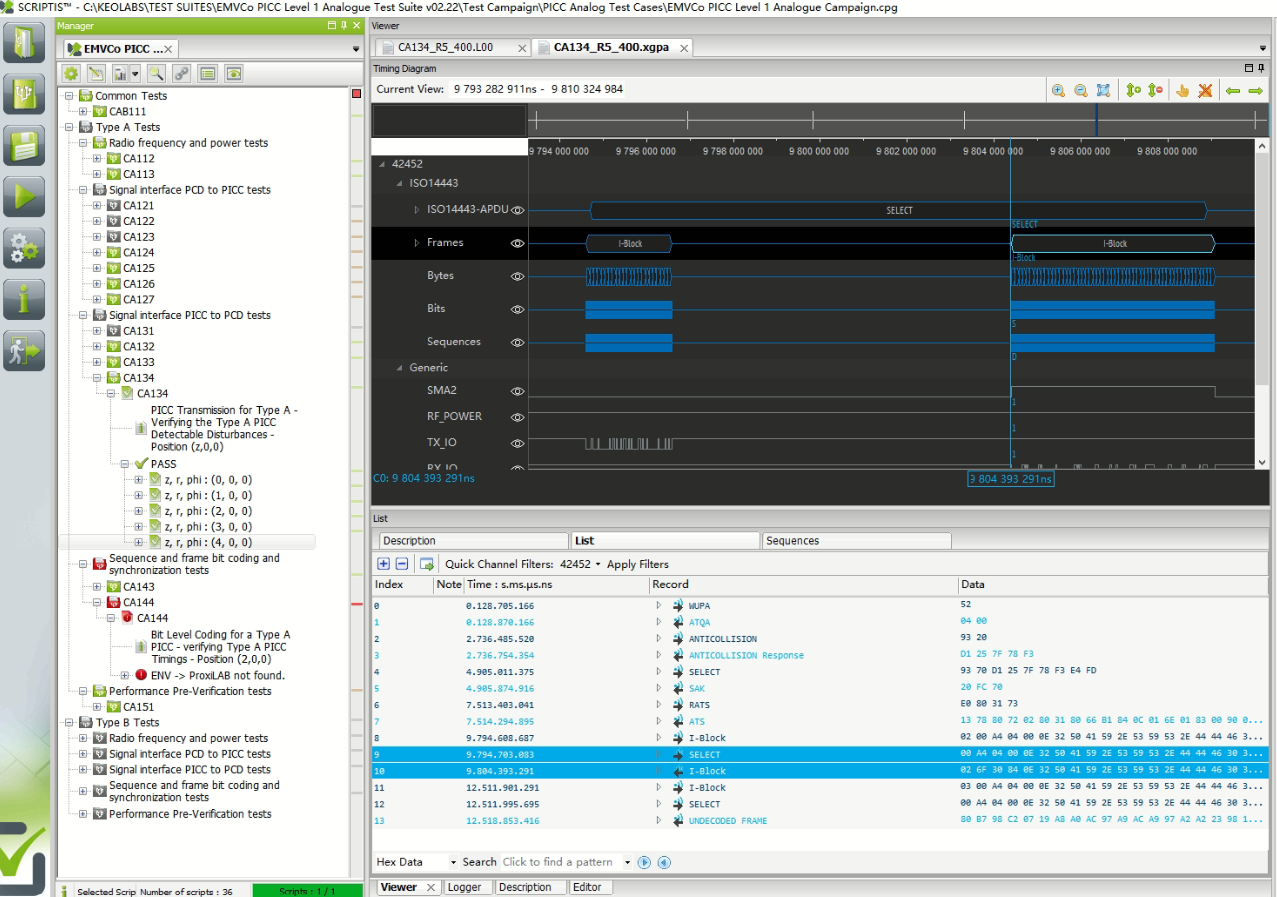
Scriptis saves test logs in xdata format:
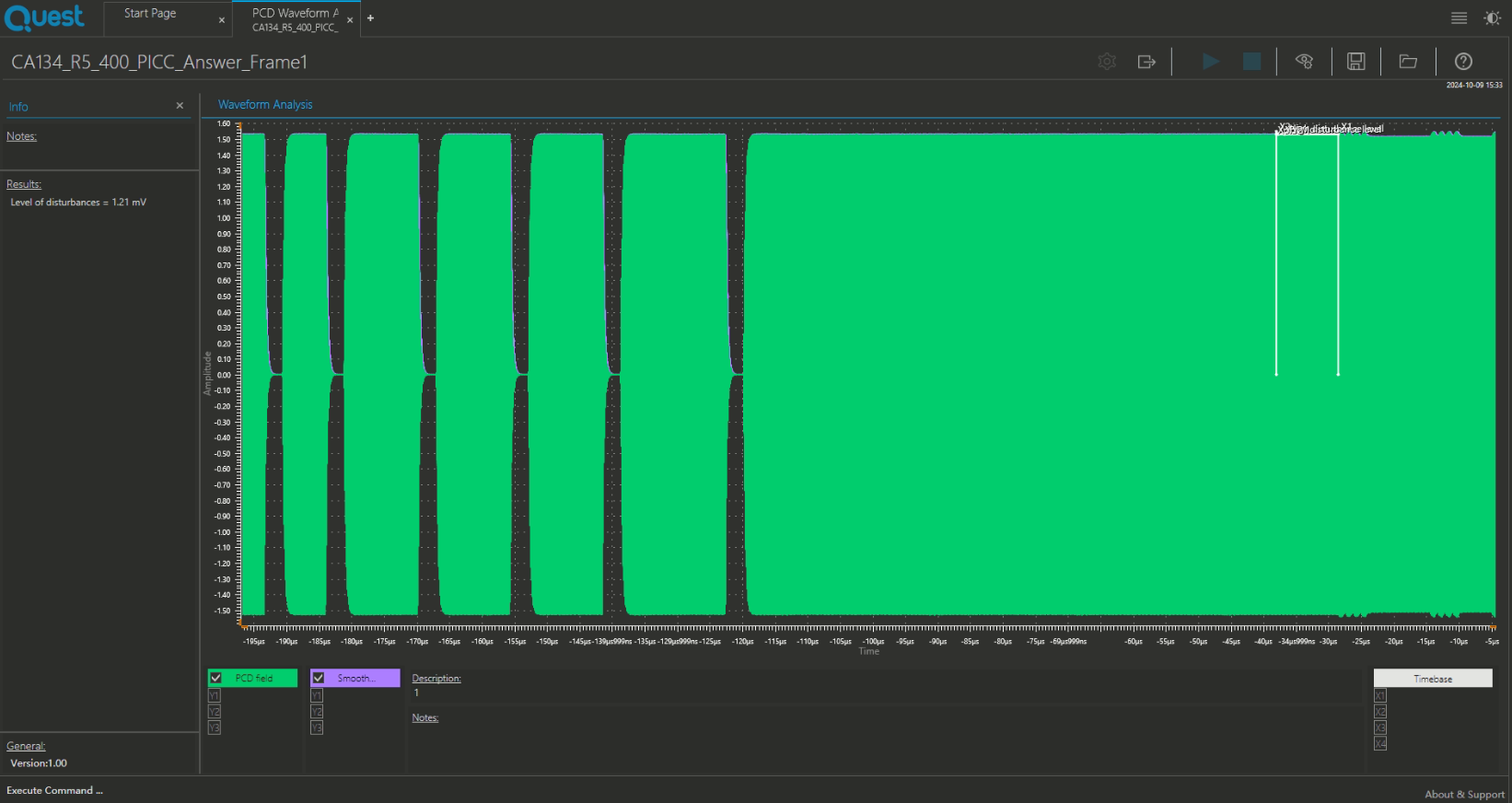
Scriptis supports exporting reports in PDF format:
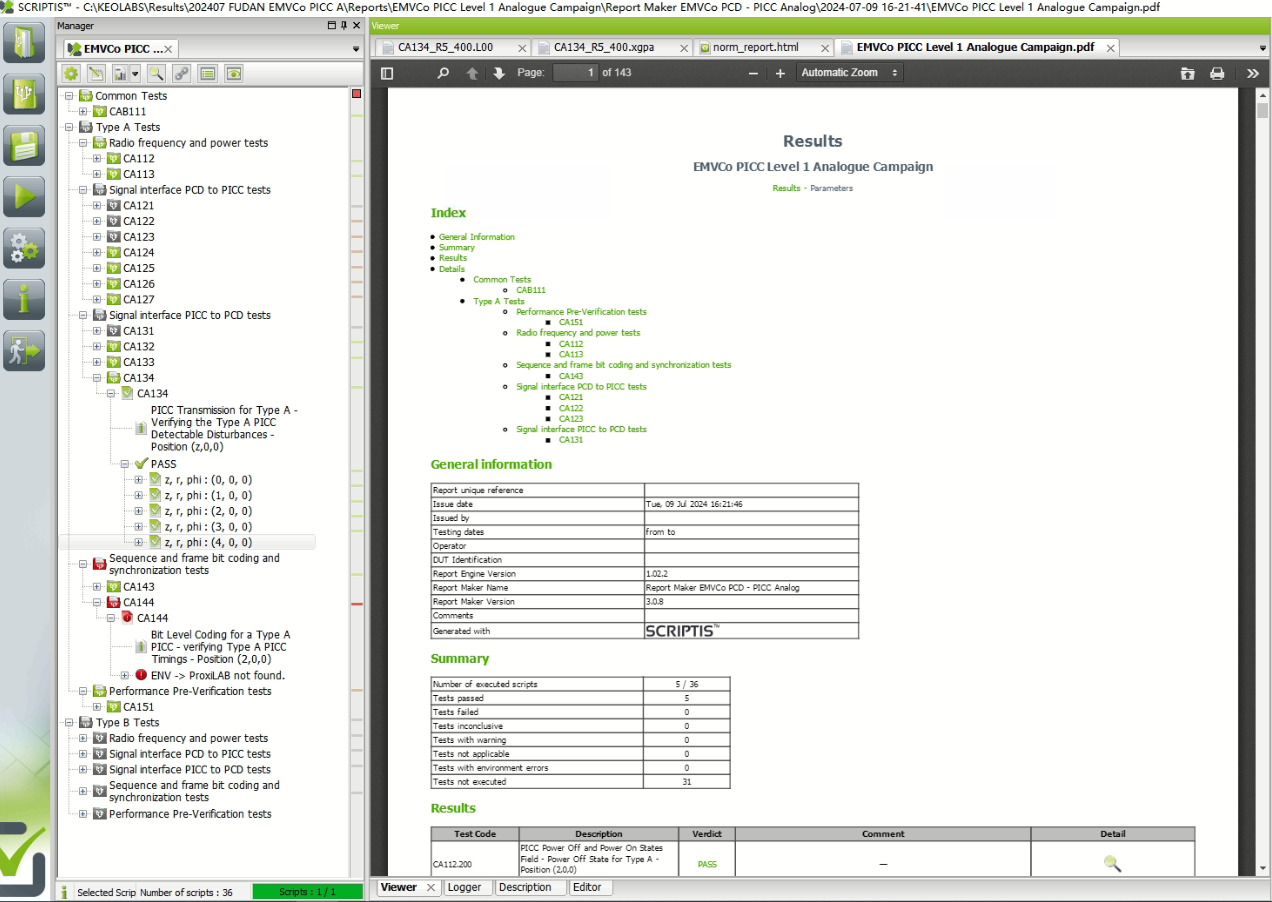
Scriptis supports exporting reports in html format:
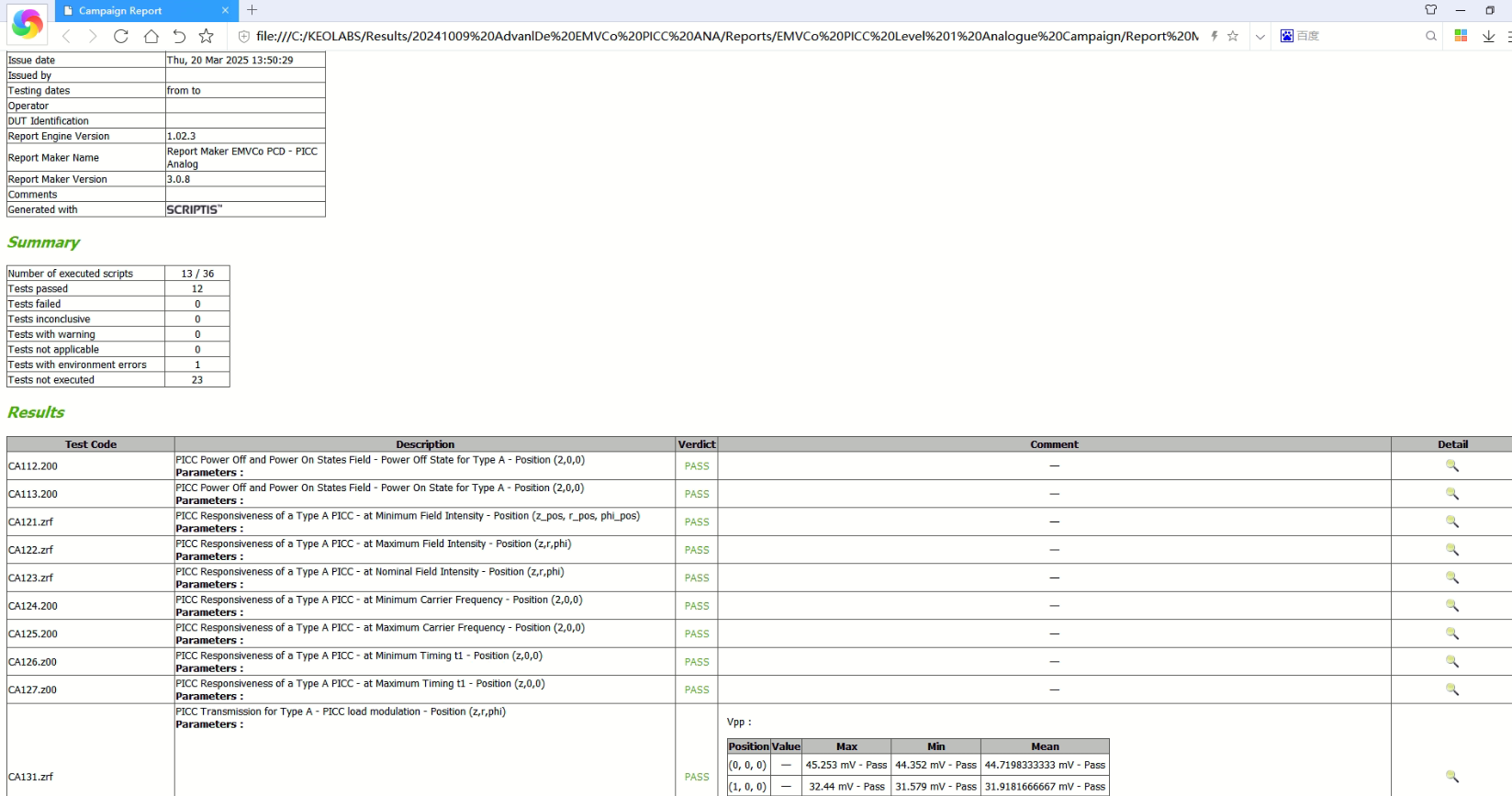
The Keolabs Solution by ABE supports verifying the following standards:
• EMV® Type Approval - Contactless Terminal Level 1
• EMV® Type Approval - Contactless Card Level 1
• NFC Forum Test Cases for Analog and Digital Protocol
• ISO/IEC 10373-6 Test Methods
• ISO/IEC 18745-2 Test Methods for the contactless interface
• CEN/TS 16794-2:2017 Public transport - Communication between contactless readers and fare media - Part 2: Test plan for ISO/IEC 14443
KEOLABS provides a complete testing solution that supports internal validation of smart cards and card readers based on industry standards for specific application types, including:
• Payment: Qualified solution to verify you payment applications - Used by EMVCo Laboratories
EMVCo Level 1 PCD Analog Test Suite
EMVCo Level 1 PCD Digital Test Suite
EMVCo Level 1 Reduced Range Terminal Analog Test Suite
EMVCo Level 1 PICC Analog Test Suite
EMVCo Level 1 PICC Digital Test Suite
EMVCo Level 1 Mobile Analog Test Suite
• ePassport & eID Products: Solution to verify your Identity Applications - Used by National Printing Companies
ISO 10373-6/ISO 18745-2 PICC Analog Test Suite
ISO 10373-6/ISO 18745-2 PICC Digital Test Suite
ePassport-eMRTD Application Test Suite
eID - Application EAC V2 & IAS ECC Test suites
eDL - Application ISO 18013-4 Test suite
• Access Control, Transport & Smart Objects: Solution to verify your Transport or Access Control Applications - Used by transport operators
ISO 10373-6 PICC Analog Test Suite
ISO 10373-6 PICC Digital Test Suite
ISO 10373-6 PCD Analog Test Suite
ISO 10373-6 PCD Digital Test Suite
• Mobile, Automotive Makers: Qualified solution to Verify your NFC Applications - Used by Mobile or automotive Makers
NFC Forum Poller&Listener Analog Test Suite
NFC Forum Poller&Listener Digital Test Suite
NFC Forum LLCP/SNEP test suite(Initiator/Target)

Current Products:EMVCo L1 PICC Test Solutions